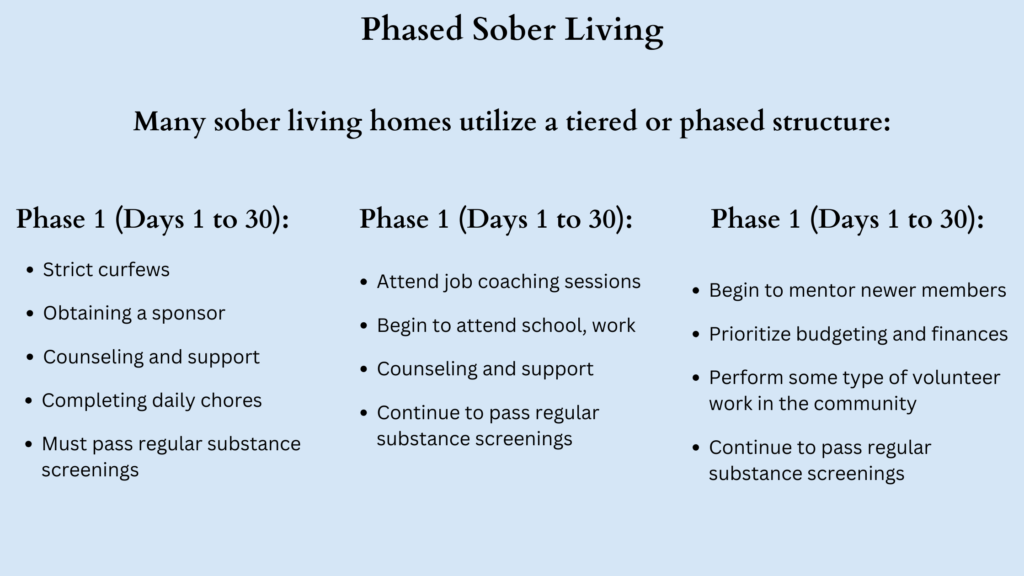Overview
Ever wondered what is a sober house & how do sober living houses work?
Imagine you’re recovering from an injury. You leave the hospital (inpatient rehab) but still need some support before you’re ready to jump back into everything (outpatient program). That’s what a sober living home is like, but for people recovering from drug or alcohol addiction.
These houses are like safe apartments where people who are getting clean can live together. It’s a supportive environment where everyone is on the same page about staying sober. There are usually rules to follow, like curfews and no drugs or alcohol allowed. But it’s not super strict like a hospital. It’s more like having roommates who understand what you’re going through and can help keep you on track.
While they’re not for everyone, sober living homes can be a great step & place to go if you are interested in giving up consumption completely. It’s like training wheels for life after rehab, helping you build the strength and independence you need to stay healthy.
We’ll explore what sober living houses are like, the good things they do, and why they’re important for people getting better. Get ready to learn about these special places where people heal in a structured way. Let’s dive in together!
What Is Sober Living Houses?
Imagine a place where people who are overcoming addiction can live for a bit after getting treatment. Think of it like a supportive halfway house. Sober living homes have rules, but they’re there to help you, not hold you back. The goal is to give you extra support while you get your feet back on the ground, learning the skills you need to stay sober on your own.
This support can be like having a helping hand in different areas. Some places offer classes to teach you life skills, like cooking healthy meals. Others might help you find a job or get back into school. Most will encourage you to join a support group where you can connect with others going through similar experiences. It’s like having a team cheering you on!
Sober living houses are purposefully structured and supportive living environments crafted to aid individuals on their journey to recovery from substance abuse. Functioning as transitional spaces, these residences act as a bridge, helping individuals transition from formal rehabilitation programs to independent, sober living.
Often referred to as halfway houses or transitional living homes, they offer a secure and substance-free haven where residents can concentrate on maintaining their sobriety and gradually reintegrate into daily life.
Sober living homes are like dorms for people who are getting better from addiction. They have rules to follow, like curfews and drug testing, to keep everyone safe and healthy. There’s also a lot of support from other people who are going through the same thing. It’s kind of like having a built-in group of friends who understand what you’re dealing with.
These homes help people avoid going back to drugs by giving them a safe place to live, people to talk to, and the skills they need to live on their own. The main goal is to help people get strong enough to live happy, independent lives without relying on drugs.

How Do Sober Living Houses Work?
Sober living houses play a crucial role in helping people recover from substance abuse. After completing formal treatment programs, many individuals choose sober living to transition back to independent living while staying focused on staying sober.
These houses have strict rules, like curfews and regular drug tests, which help residents gradually apply the skills they learned in treatment. Living with others who share the same goals creates a supportive community where everyone helps each other stay sober. Following the rules teaches discipline and reduces the risk of relapse.
In addition to the structured environment and peer support, sober living houses encourage residents to participate in 12-step programs and other activities related to recovery. This involvement reinforces their commitment to staying sober. Plus, these houses help residents develop important life skills, like finding a job and managing money. This well-rounded approach not only supports recovery but also prepares people for life after they leave the sober living house.
By providing a drug-free environment, peer support, and personal accountability, sober living houses give residents a strong foundation for staying sober. The gradual process of reintegrating into independent living helps build confidence and resilience, setting them up for long-term success in recovery.
Understanding the Levels of Support in Sober Living Homes
Choosing a sober living home is a crucial step in the recovery journey. However, with different facilities offering varying levels of support, the options can sometimes feel overwhelming. This guide provides an overview of common levels of support found in sober living homes, helping you identify the best fit for your individual needs.
Level I: Peer-Run Homes:
- Structure: These homes offer minimal formal structure, relying on residents to establish and enforce shared guidelines.
- Staffing: No paid staff on-site, with residents taking turns on chores and managing house logistics.
- Support: Peer support groups and self-help programs are encouraged, and often facilitated by experienced residents.
- Benefits: Strong sense of community and self-reliance, suitable for individuals with a high level of personal responsibility and commitment to recovery.
Level II: Monitored Homes:
- Structure: More defined daily routines and expectations, with a house manager or senior resident overseeing operations.
- Staffing: At least one paid staff member is responsible for supervision, conflict resolution, and providing support.
- Support: Regular group meetings, individual support sessions, and access to external resources like therapy or case management.
- Benefits: Balance of personal freedom and accountability, ideal for individuals who need some external guidance while building independent living skills.
Level III: Supervised Homes:
- Structure: Highly structured environment with established curfews, drug testing, and clear consequences for rule violations.
- Staffing: Professional staff team providing 24/7 supervision, medication management and intensive life skills training.
- Support: Structured group therapy sessions, individual counseling, and comprehensive relapse prevention programs.
- Benefits: Ideal for individuals requiring a high level of professional support and structure, often transitioning from more intensive treatment programs.
Level IV: Service Provider Homes:
- Structure: Highly structured and controlled environment with specialized clinical programming and constant supervision.
- Staffing: Credentialed clinical staff, therapists, and case managers providing comprehensive treatment and support services.
- Support: Individualized therapy plans, medical care, vocational training, and intensive relapse prevention programs.
- Benefits: Suitable for individuals with complex needs or co-occurring mental health conditions, requiring comprehensive clinical interventions.
Understanding the levels of support available in sober living homes allows individuals to choose an environment that aligns with their current needs and goals in recovery. Residents need to communicate openly with house managers, assess their progress, and select a level of support that facilitates their journey toward sustained sobriety and successful independent living.
How Sober Living Houses Empower Long-Term Recovery
Recovery is a lifelong journey, and every step forward counts. Sober living houses play a crucial role in helping individuals rebuild their lives by providing a safe, structured, and supportive environment. Beyond offering a roof over your head, these homes foster a sense of community, accountability, and personal growth that can be transformative during recovery.
1. A Sense of Belonging Through Community
Living in a sober house means surrounding yourself with individuals who share the same challenges and aspirations. This sense of belonging reduces feelings of isolation and creates a support network where residents uplift and encourage one another.
2. Daily Structure for Stability
Sober living houses balance independence with structure. Residents often follow daily routines, such as group meals, shared responsibilities, and regular therapy sessions. These activities reinforce positive habits, build discipline, and provide a foundation for long-term sobriety.
3. Accountability That Drives Growth
Accountability is a cornerstone of sober living. Knowing that others rely on you for shared tasks or emotional support fosters a sense of responsibility. This not only strengthens trust but also empowers residents to remain committed to their recovery goals.
4. Reducing Relapse Risks
By eliminating high-risk situations and encouraging a focus on sobriety, sober living houses help reduce the chances of relapse. Residents learn to identify triggers, build resilience, and navigate life’s challenges in a supportive setting.
5. Inspiration for the Journey Ahead
Recovery doesn’t happen overnight, but every day spent in a sober living house is a step closer to a brighter, healthier future. Whether it’s forming new habits, finding a supportive community, or staying accountable, these homes empower individuals to reclaim their lives one day at a time.
Benefits of Sober Living Homes
Choosing to spend time in a substance abuse halfway house comes with many advantages. Let’s explore some of them:
- Learning Important Life Skills
- These homes often provide classes to teach practical skills like cooking, budgeting, or finding a job.
- The goal is to help you become more independent and confident as you rebuild your life.
- A Safe and Stable Place to Stay
- If you don’t have a steady or supportive home to return to after rehab, sober living homes give you a secure and drug-free environment.
- It’s a place where you can focus on your recovery without distractions or triggers.
- Support from a Caring Community
- You’ll be surrounded by people who understand what you’re going through and are working toward the same goal of staying sober.
- This positive environment helps you build friendships and find encouragement to stay on the right path.
- A Smooth Transition After Rehab
- Moving back to normal life after rehab can feel overwhelming. Sober living homes act as a stepping stone, giving you time to adjust.
- They let you practice what you’ve learned in rehab while still having structure and support around you.
Exploring the Dynamics of a Sober-Living House
A sober living house, also known as a halfway house, serves as a supportive and transitional living arrangement for individuals recovering from substance abuse. Here’s a glimpse into what a sober living house is like:
1. Structured Environment:
- Sober-living houses maintain a structured and organized environment. Residents are expected to adhere to specific rules and guidelines, fostering a sense of discipline and routine.
2. Supportive Community:
- These houses create a supportive community where individuals share common goals of maintaining sobriety. The communal living setup encourages peer support, understanding, and camaraderie among residents.
3. Accountability Measures:
- Accountability is a fundamental aspect. Residents are accountable for their actions, and adherence to house rules, which may include curfews and regular drug testing, is crucial. This accountability aids in cultivating responsibility and discipline.
4. Therapeutic Resources:
- Sober-living houses often provide access to therapeutic resources, including support group meetings, counseling sessions, and other recovery-oriented activities. This contributes to the overall well-being of residents.
5. Life Skills Development:
- Residents receive assistance in developing essential life skills such as job searching, resume building, and financial management. This holistic approach prepares individuals for successful independent living post-recovery.
6. Safe and Drug-Free Environment:
- Maintaining a safe and drug-free environment is a priority. The houses are committed to providing a setting where residents can focus on their recovery without exposure to substances.
7. Gradual Independence:
- Sober-living houses support a gradual reintegration into independent living. This step-by-step approach helps residents build confidence and resilience, minimizing the risk of setbacks.
8. Guidance and Structure:
- There is typically guidance from house managers or staff who ensure the smooth functioning of the house. This guidance adds an extra layer of support and structure for residents.
9. Community Engagement:
- Residents are encouraged to actively participate in community-based activities, 12-step programs, and therapy sessions. This involvement reinforces the commitment to recovery and creates a sense of community engagement.
10. Positive Atmosphere:
- Sober-living houses aim to create a positive and uplifting atmosphere. This positivity contributes to the overall mental and emotional well-being of residents.
In summary, a sober living house provides a structured, supportive, and drug-free environment where individuals in recovery can navigate their journey toward independent and sober living. The focus on accountability, community support, and skill development makes these houses integral to recovery.
How Long Can You Stay in a Sober Living Home?
Taking the courageous step to enter a sober living home marks a significant stride toward lasting recovery. Within this supportive environment, individuals have the opportunity to not only rebuild their lives but also manage sobriety during the critical transition back to independent living. However, as this new chapter unfolds, a pertinent question arises: “How long can I stay here?“
In reality, there’s no universal answer tailored to everyone’s journey. The duration of stay is a nuanced decision influenced by various factors unique to each individual. Considerations include:
- Personal Progress: Progress within a sober living home is a personal journey. Elements such as your commitment to recovery, the effectiveness of your relapse prevention plan, and your overall well-being play pivotal roles in determining the ideal timeframe.
- House Policies: Each sober living house operates under distinct guidelines concerning the minimum and maximum length of stay. Some emphasize short-term stays (around 3-6 months) as foundational steps, while others provide extended support for a more prolonged duration.
- Financial Considerations: To cover rent, utilities, and shared expenses, most sober living houses require financial contributions. Evaluating your financial resources and engaging in discussions with the house manager about payment plans is essential in this decision-making process.
- External Factors: External factors, such as job searches, educational opportunities, or family situations, can significantly impact the length of your stay. Maintaining open communication with the house manager ensures that any external circumstances influencing your planned timeline are addressed.
It’s crucial to bear in mind that the ultimate goal of a sober living home is to equip individuals with the skills and confidence needed to thrive independently. Therefore, the duration of your stay should strike a balance – long enough to instill a sense of security in your sobriety yet flexible enough to adapt to your evolving needs.
In navigating this decision-making process, it’s beneficial to consult with the house manager for insights into specific policies and to develop a realistic plan. Additionally, seeking guidance from your support network, including therapists, sponsors, or recovery mentors, can offer valuable perspectives tailored to your unique journey. Ultimately, prioritize your well-being, listen to your needs, and adjust your timeline accordingly, recognizing that recovery is a marathon rather than a sprint.
Conclusion
In summary, the exploration of “how do sober living houses work” reveals a narrative of resilience, support, and transformation. These homes operate as more than just transitional spaces; they are catalysts for change, providing individuals with the structure, community, and resources necessary for their recovery journey.
The intricate dance between accountability and autonomy creates an environment where residents can not only rebuild their lives but also rediscover their strengths and capabilities. As these guiding steps unfold, sober living houses become integral partners on the road to recovery, illuminating a path toward lasting sobriety and a renewed sense of purpose.
Now, we invite you to share your insights and experiences. Have you or someone you know navigated the path of recovery through a sober living house? What aspects stood out to you in the process? Your unique perspective can offer valuable insights and encouragement to others on their own recovery journeys.










